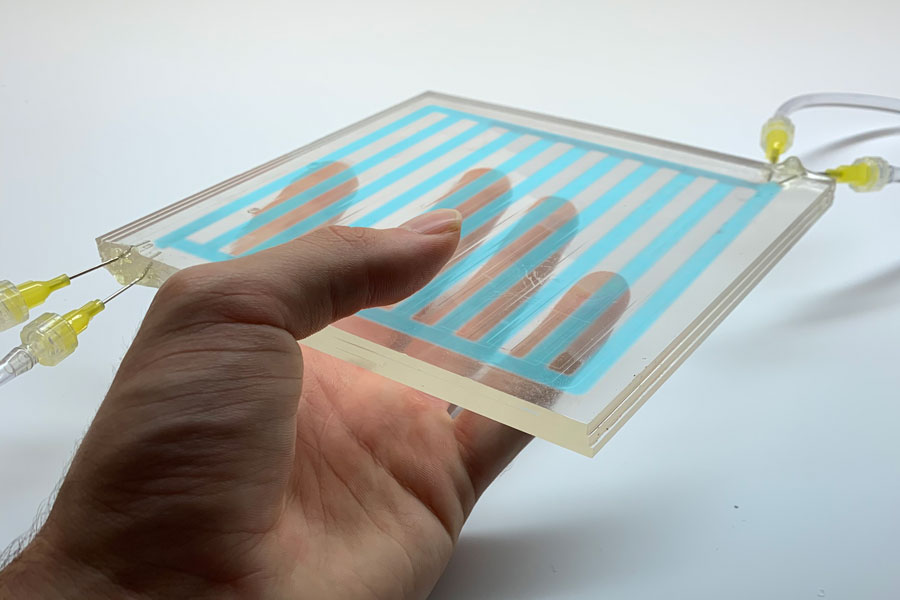
Tom van Nunen and test setup. Photo: Huib Visser
More than 43 million people worldwide are blind. In the past 30 years, that number has increased by roughly 50 percent. Most blind people are born with normal vision and lose their sight over time, due to medical causes or an accident. Often, the visual cortex in the brain is still capable of interpreting electrical signals, but the eyes or the connection between the eyes and brain are damaged or lost. It is possible to restore some form of sight by providing the right electrical signals to the visual cortex with an implant. PhD researcher Tom van Nunen has designed a wireless energy transfer system to safely and reliably connect to the implant, and developed a prototype.
Optical information is picked up by the eyes and sent with neuroelectric signals to the visual cortex in the brain. Interpreting this input is what people perceive as seeing. It is known that even blind people are able to perceive some visual cues when their cortex is stimulated by electrical signals.
By establishing a connection between an external image source, such as a camera, and electrodes implanted in the visual cortex, a blind individual can experience a crude form of vision with these visual stimuli.
The NESTOR project, of which Van Nunens’s research is part, aims to create such a visual prosthesis. The brain implant the team is currently developing includes systems for wireless data transfer, controlling the electrodes and wireless energy transfer, among other things.
More than 43 million people worldwide are blind. In the past 30 years, that number has increased by roughly 50 percent. Most blind people are born with normal vision and lose their sight over time, due to medical causes or an accident. Often, the visual cortex in the brain is still capable of interpreting electrical signals, but the eyes or the connection between the eyes and brain are damaged or lost. It is possible to restore some form of sight by providing the right electrical signals to the visual cortex with an implant. PhD researcher Tom van Nunen has designed a wireless energy transfer system to safely and reliably connect to the implant, and developed a prototype.
Optical information is picked up by the eyes and sent with neuroelectric signals to the visual cortex in the brain. Interpreting this input is what people perceive as seeing. It is known that even blind people are able to perceive some visual cues when their cortex is stimulated by electrical signals.
By establishing a connection between an external image source, such as a camera, and electrodes implanted in the visual cortex, a blind individual can experience a crude form of vision with these visual stimuli.
The NESTOR project, of which Van Nunens’s research is part, aims to create such a visual prosthesis. The brain implant the team is currently developing includes systems for wireless data transfer, controlling the electrodes and wireless energy transfer, among other things.
Original Article: Wireless power makes blind people see again
More from: Eindhoven University of Technology
The Latest Updates from Bing News
Go deeper with Bing News on:
Visual prosthesis
- Nicole Kidman’s 12 Best Film Performances, From ‘Birth’ to ‘Moulin Rouge’
Variety ranks Nicole Kidman's best movies & performances including "Moulin Rouge," "The Hours," "To Die For," "Birth," "Rabbit Hole" and "Dogville." ...
- What Would a Best Stunt Oscar Category Look Like?
Guy" team has led the push for the Academy Awards to recognize stunts, so we asked what would warrant a nomination.
- 65 Best Hulu Shows and Original Series to Watch (April 2024)
Check out our ever-expanding list of the best shows streaming on Hulu right now, including cult favorites, new classics, and much more.
- BCI maker Science acquires retinal implant from Pixium Vision
Brain-computer interface developer Science Corporation acquired the IP and related assets for the Pixium Vision Prima implant.
- Emma Stone, Benny Safdie and Nathan Fielder Submit Multiple Emmy Bids With Drama Series ‘The Curse’ (EXCLUSIVE)
Showtime’s satirical thriller “ The Curse ,” created by stars Nathan Fielder and Benny Safdie and also starring Emma Stone, has exclusively shared its Emmy submission plans with Variety. The three ...
Go deeper with Bing News on:
Restoring vision
- Column: Restore Fort Monroe’s 1619 name: Point Comfort
Restore the name of Point Comfort and highlight Fort Monroe as the fourth point in Virginia’s “Historic Diamond,” Poquoson’s Steven T. Corneliussen writes in a guest column.
- Federal funds to help restore Lake Superior sandbar
Preservation of rare coastal dunes and old-growth pines will be central to restoration plans for the western end of Wisconsin Point, the Lake Superior sandbar in Superior, Wis., that for centuries has ...
- Diplopia (Double Vision) and Treatment Effectiveness
Diplopia causes people to see double. It’s a symptom of many conditions, some of which don’t originate in the eyes, such as diabetes. Learn more.
- Science Corporation acquires retinal implant from Pixium Vision
S cience Corporation, a brain-computer interface technology company, has announced the acquisition of intellectual property and related assets for the Prima retinal implant from French bioelectronics ...
- Eyes wide open: Breakthrough blink restoration
N.K. often happens after an infection or trauma to the head or neck. Brain and skull base tumors are also common causes of N.K. Failing to blink can damage the cornea, causing cloudy and blurry vision ...










